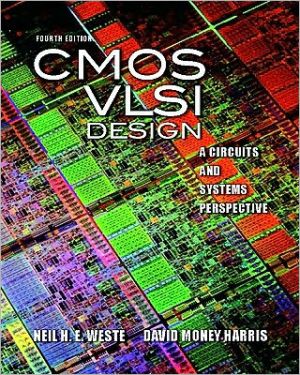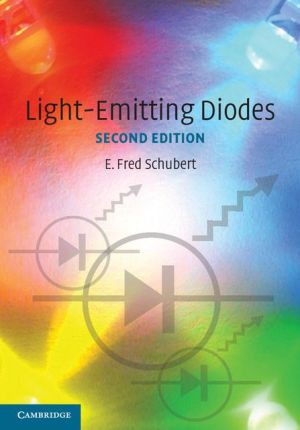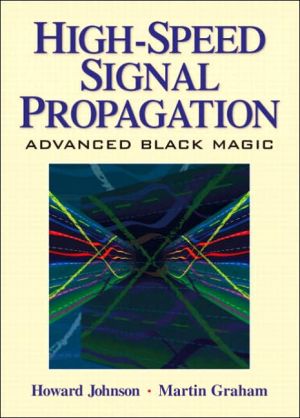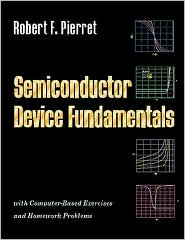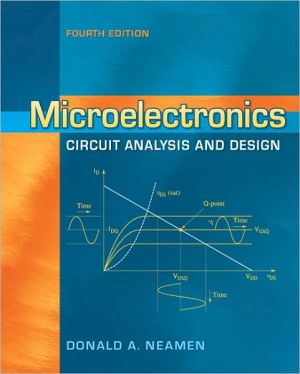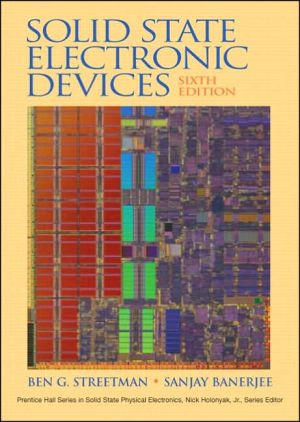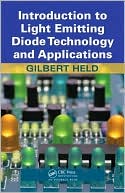Fundamentals of Semiconductors: Physics and Materials Properties
Search in google:
This fourth edition of the well-established Fundamentals of Semiconductors serves to fill the gap between a general solid-state physics textbook and research articles by providing detailed explanations of the electronic, vibrational, transport, and optical properties of semiconductors. The approach is physical and intuitive rather than formal and pedantic. Theories are presented to explain experimental results. This textbook has been written with both students and researchers in mind. Its emphasis is on understanding the physical properties of Si and similar tetrahedrally coordinated semiconductors. The explanations are based on physical insights. Each chapter is enriched by an extensive collection of tables of material parameters, figures, and problems. Many of these problems "lead the student by the hand" to arrive at the results.The major changes made in the fourth edition include: an extensive appendix about the important and by now well-established deep center known as the DX center, additional problems and the solutions to over fifty of the problems at the end of the various chapters. Some of the solutions contain extensionst via discussions about topics of current interest in the field of semiconductor physics, such as spin-orbit coupling and k-linear band dispersion.
1 Introduction 11.1 A Survey of Semiconductors 21.1.1 Elemental Semiconductors 21.1.2 Binary Compounds 21.1.3 Oxides 31.1.4 Layered Semiconductors 31.1.5 Organic Semiconductors 41.1.6 Magnetic Semiconductors 41.1.7 Other Miscellaneous Semiconductors 41.2 Growth Techniques 51.2.1 Czochralski Method 51.2.2 Bridgman Method 61.2.3 Chemical Vapor Deposition 71.2.4 Molecular Beam Epitaxy 81.2.5 Fabrication of Self-Organized Quantum Dots by the Stranski-Krastanow Growth Method 111.2.6 Liquid Phase Epitaxy 13Summary 14Periodic Table of "Semiconductor-Forming" Elements 152 Electronic Band Structures 172.1 Quantum Mechanics 182.2 Translational Symmetry and Brillouin Zones 202.3 A Pedestrian's Guide to Group Theory 252.3.1 Definitions and Notations 252.3.2 Symmetry Operations of the Diamond and Zinc-Blende Structures 302.3.3 Representations and Character Tables 322.3.4 Some Applications of Character Tables 402.4 Empty Lattice or Nearly Free Electron Energy Bands 482.4.1 Nearly Free Electron Band Structure in a Zinc-Blende Crystal 482.4.2 Nearly Free Electron Energy Bands in Diamond Crystals 522.5 Band Structure Calculations by Pseudopotential Methods 582.5.1 Pseudopotential Form Factors in Zinc-Blende- and Diamond-Type Semiconductors 612.5.2 Empirical and Self-Consistent Pseudopotential Methods 662.6 The k-p Method of Band-Structure Calculations 682.6.1 Effective Mass of a Nondegenerate Band Using the k-p Method 692.6.2 Band Dispersion near a Degenerate Extremum: Top Valence Bands in Diamond and Zinc-Blende-Type Semiconductors 712.7 Tight-Binding or LCAO Approach to the Band Structure of Semiconductors 832.7.1 Molecular Orbitals and Overlap Parameters 832.7.2 Band Structure of Group-IV Elements by the Tight-Binding Method 872.7.3 Overlap Parameters and Nearest-Neighbor Distances 94Problems 96Summary 1053 Vibrational Properties of Semiconductors, and Electron-Phonon Interactions 1073.1 Phonon Dispersion Curves of Semiconductors 1103.2 Models for Calculating Phonon Dispersion Curves of Semiconductors 1143.2.1 Force Constant Models 1143.2.2 Shell Model 1143.2.3 Bond Models 1153.2.4 Bond Charge Models 1173.3 Electron-Phonon Interactions 1213.3.1 Strain Tensor and Deformation Potentials 1223.3.2 Electron-Acoustic-Phonon Interaction at Degenerate Bands 1273.3.3 Piezoelectric Electron-Acoustic-Phonon Interaction 1303.3.4 Electron-Optical-Phonon Deformation Potential Interactions 1313.3.5 Frohlich Interaction 1333.3.6 Interaction Between Electrons and Large-Wavevector Phonons: Intervalley Electron-Phonon Interaction 135Problems 137Summary 1584 Electronic Properties of Defects 1594.1 Classification of Defects 1604.2 Shallow or Hydrogenic Impurities 1614.2.1 Effective Mass Approximation 1624.2.2 Hydrogenic or Shallow Donors 1664.2.3 Donors Associated with Anisotropic Conduction Bands 1714.2.4 Acceptor Levels in Diamond and Zinc-Blende-Type Semiconductors 1744.3 Deep Centers 1804.3.1 Green's Function Method for Calculating Defect Energy Levels 1834.3.2 An Application of the Green's Function Method: Linear Combination of Atomic Orbitals 1884.3.3 Another Application of the Green's Function Method: Nitrogen in GaP and GaAsP Alloys 1924.3.4 Final Note on Deep Centers 197Problems 198Summary 2025 Electrical Transport 2035.1 Quasi-Classical Approach 2035.2 Carrier Mobility for a Nondegenerate Electron Gas 2065.2.1 Relaxation Time Approximation 2065.2.2 Nondegenerate Electron Gas in a Parabolic Band 2075.2.3 Dependence of Scattering and Relaxation Times on Electron Energy 2085.2.4 Momentum Relaxation Times 2095.2.5 Temperature Dependence of Mobilities 2205.3 Modulation Doping 2235.4 High-Field Transport and Hot Carrier Effects 2255.4.1 Velocity Saturation 2275.4.2 Negative Differential Resistance 2285.4.3 Gunn Effect 2305.5 Magneto-Transport and the Hall Effect 2325.5.1 Magneto-Conductivity Tensor 2325.5.2 Hall Effect 2345.5.3 Hall Coefficient for Thin Film Samples (van der Pauw Method) 2355.5.4 Hall Effect for a Distribution of Electron Energies 236Problems 237Summary 2416 Optical Properties I 2436.1 Macroscopic Electrodynamics 2446.1.1 Digression: Units for the Frequency of Electromagnetic Waves 2476.1.2 Experimental Determination of Optical Functions 2476.1.3 Kramers-Kronig Relations 2506.2 The Dielectric Function 2536.2.1 Experimental Results 2536.2.2 Microscopic Theory of the Dielectric Function 2546.2.3 Joint Density of States and Van Hove Singularities 2616.2.4 Van Hove Singularities in εi 2626.2.5 Direct Absorption Edges 2686.2.6 Indirect Absorption Edges 2696.2.7 "Forbidden" Direct Absorption Edges 2736.3 Excitons 2766.3.1 Exciton Effect at M0 Critical Points 2796.3.2 Absorption Spectra of Excitons 2826.3.3 Exciton Effect at M1 Critical Points or Hyperbolic Excitons 2886.3.4 Exciton Effect at M3 Critical Points 2916.4 Phonon-Polaritons and Lattice Absorption 2926.4.1 Phonon-Polaritons 2956.4.2 Lattice Absorption and Reflection 2986.4.3 Multiphonon Lattice Absorption 2996.4.4 Dynamic Effective Ionic Charges in Heteropolar Semiconductors 3036.5 Absorption Associated with Extrinsic Electrons 3056.5.1 Free-Carrier Absorption in Doped Semiconductors 3066.5.2 Absorption by Carriers Bound to Shallow Donors and Acceptors 3116.6 Modulation Spectroscopy 3156.6.1 Frequency Modulated Reflectance and Thermoreflectance 3196.6.2 Piezoreflectance 3216.6.3 Electroreflectance (Franz-Keldysh Effect) 3226.6.4 Photoreflectance 3296.6.5 Reflectance Difference Spectroscopy 3326.7 Addendum (Third Edition): Dielectric Function 333Problems 334Summary 3437 Optical Properties II 3457.1 Emission Spectroscopies 3457.1.1 Band-to-Band Transitions 3517.1.2 Free-to-Bound Transitions 3547.1.3 Donor-Acceptor Pair Transitions 3567.1.4 Excitons and Bound Excitons 3627.1.5 Luminescence Excitation Spectroscopy 3697.2 Light Scattering Spectroscopies 3757.2.1 Macroscopic Theory of Inelastic Light Scattering by Phonons 3757.2.2 Raman Tensor and Selection Rules 3787.2.3 Experimental Determination of Raman Spectra 3857.2.4 Microscopic Theory of Raman Scattering 3947.2.5 A Detour into the World of Feynman Diagrams 3957.2.6 Brillouin Scattering 3987.2.7 Experimental Determination of Brillouin Spectra 4007.2.8 Resonant Raman and Brillouin Scattering 401Problems 422Summary 4268 Photoelectron Spectroscopy 4278.1 Photoemission 4318.1.1 Angle-Integrated Photoelectron Spectra of the Valence Bands 4408.1.2 Angle-Resolved Photoelectron Spectra of the Valence Bands 4438.1.3 Core Levels 4518.2 Inverse Photoemission 4568.3 Surface Effects 4578.3.1 Surface States and Surface Reconstruction 4578.3.2 Surface Energy Bands 4588.3.3 Fermi Level Pinning and Space Charge Layers 460Problems 465Summary 4689 Effect of Quantum Confinement on Electrons and Phonons in Semiconductors 4699.1 Quantum Confinement and Density of States 4709.2 Quantum Confinement of Electrons and Holes 4739.2.1 Semiconductor Materials for Quantum Wells and Superlattices 4749.2.2 Classification of Multiple Quantum Wells and Superlattices 4789.2.3 Confinement of Energy Levels of Electrons and Holes 4799.2.4 Some Experimental Results 4899.3 Phonons in Superlattices 4949.3.1 Phonons in Superlattices: Folded Acoustic and Confined Optic Modes 4949.3.2 Folded Acoustic Modes: Macroscopic Treatment 4999.3.3 Confined Optical Modes: Macroscopic Treatment 5009.3.4 Electrostatic Effects in Polar Crystals: Interface Modes 5029.4 Raman Spectra of Phonons in Semiconductor Superlattices 5119.4.1 Raman Scattering by Folded Acoustic Phonons 5119.4.2 Raman Scattering by Confined Optical Phonons 5169.4.3 Raman Scattering by Interface Modes 5189.4.4 Macroscopic Models of Electron-LO Phonon (Frohlich) Interaction in Multiple Quantum Wells 5219.5 Electrical Transport: Resonant Tunneling 5259.5.1 Resonant Tunneling Through a Double-Barrier Quantum Well 5269.5.2 I-V Characteristics of Resonant Tunneling Devices 5299.6 Quantum Hall Effects in Two-Dimensional Electron Gases 5339.6.1 Landau Theory of Diamagnetism in a Three-Dimensional Free Electron Gas 5349.6.2 Magneto-Conductivity of a Two-Dimensional Electron Gas: Filling Factor 5379.6.3 The Experiment of von Klitzing, Pepper and Dorda 5389.6.4 Explanation of the Hall Plateaus in the Integral Quantum Hall Effect 5419.7 Concluding Remarks 545Problems 546Summary 551Appendix A Pioneers of Semiconductor Physics Remember... 553Ultra-Pure Germanium: From Applied to Basic Research or an Old Semiconductor Offering New Opportunities Eugene E. Haller Haller, Eugene E. 555Two Pseudopotential Methods: Empirical and Ab Initio Marvin L. Cohen Cohen, Marvin L. 558The Early Stages of Band-Structures Physics and Its Struggles for a Place in the Sun Conyers Herring Herring, Conyers 560Cyclotron Resonance and Structure of Conduction and Valence Band Edges in Silicon and Germanium Charles Kittel Kittel, Charles 563Optical Properties of Amorphous Semiconductors and Solar Cells Jan Tauc Tauc, Jan 566Optical Spectroscopy of Shallow Impurity Centers Elias Burstein Burstein, Elias 569On the Prehistory of Angular Resolved Photoemission Neville V. Smith Smith, Neville V. 574The Discovery and Very Basics of the Quantum Hall Effect Klaus von Klitzing von Klitzing, Klaus 576The Birth of the Semiconductor Superlattice Leo Esaki Esaki, Leo 578Appendix B Solutions to Some of the Problems 582Appendix C Recent Development 673Appendix D Recent Developments and References 687References 719Subject Index 755

